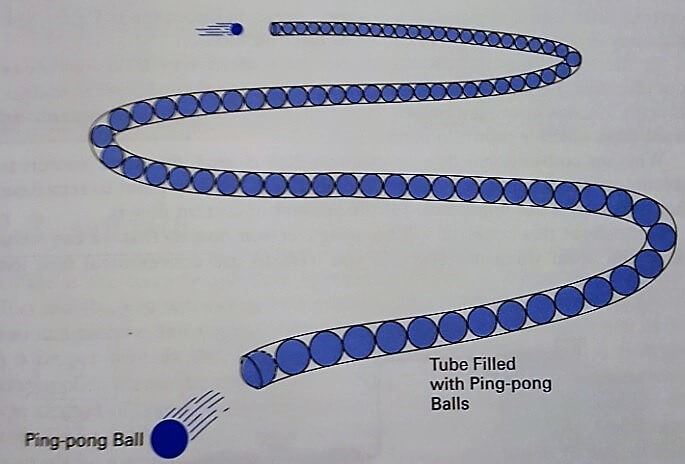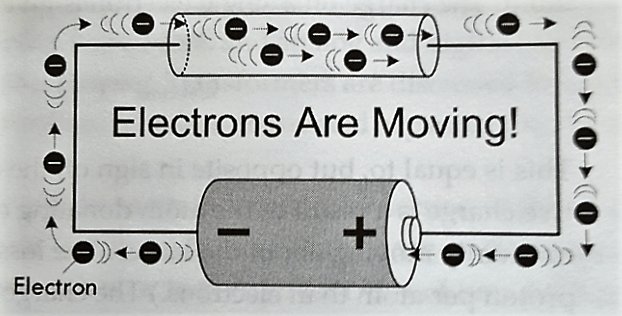
Conventional Current Flow vs. Electron Flow – Which is Right?
The debate rages on. Some say conventional current flow is correct. Others insist that electron current flow is right.
Let’s bust this thing wide open.
I’ll get back to the basics, take a look at both, see how each works, and squash this debate once and for all.
If you’re new to electronics you may not have heard this argument (yet). If you’re a veteran, then there’s no doubt you’ve heard from both sides of the camp.
We’ll start by taking a look at what current flow really is and then treat each one separately before we talk about which one is indeed correct.
What is Current Flow?
For most of us, this is a no-brainer. Current is the flow of electrons. Most of us tend to think that electricity (or electrons) travels very fast, perhaps the speed of light.
Some would be surprised to find out that if they were able to observe the path of one electron, it’s speed would be very slow. In fact, you walk faster than an electron travels in a typical conductor.
Conductors usually consist of metal. Metals have atoms containing a lot of free electrons. With an electromotive force (EMF) applied, the electrons “jump” from one atom to the next, creating current flow.
But how can they be so darn slow when the light comes on the instant you flip the wall switch or the email you send to the other side of the world arrives in 2 seconds?
The speed of any given electron is slow because it collides with other atoms in the conductor.
Become the Maker you were born to be. Try Arduino Academy for FREE!

To see why your light comes on instantly, it’s helpful to view a current carrying conductor as a tube filled end to end with ping pong balls. If you insert a new ball into one end, the speed of any given ball is slow and it only moves a bit. However, another ball immediately issues from the opposite end of the tube. The illustration below can help you visualize this.

Therefore, the effective speed of electricity is the speed of light. That’s why your cousin on the other side of the Earth gets your email in a few seconds (after being routed through various switches, servers, and other gear that makes up the ‘Net).
What is Conventional Current Flow?
Conventional current flow is the one most often used. It states that electrons flow from positive to negative. In the image below, we can see current moving from the positive terminal of the battery through the resistance to the negative terminal of the battery. This illustrates conventional current flow.

What is Electron Current Flow?
Electron flow is simply the opposite of conventional current flow. Current flows from the negative side of the battery through the resistance to the positive side rather than vice versa. So, if the arrow from the picture above were at the bottom of the circuit diagram, this would illustrate electron flow.
Which is Right: Conventional Current Flow or Electron Flow?
In the eighteenth century when Benjamin Franklin and others were doing their experiments, very little was known about the mysterious (at the time) force called electricity that they were dealing with.
Franklin had a convention of assigning positive charge signs to the “things” that were moving in a circuit doing work.
It turns out that Franklin was wrong, at least about the sign of the charges that move. Later, a physicist named Joseph Thomson performed an experiment that isolated the charges. He found that they were moving in the opposite direction of conventional current, the convention that Franklin surmised earlier. Also, we know that electrons are free to move and protons are not from other experimental evidence.
The truth is that electron flow is technically correct – current flows from negative to positive in conductors. There are things such as plasma and certain liquids in which positive charge can flow, but few of us will be dealing with such things at our work bench.

So why do we still mostly use conventional current flow if it’s wrong?
It turns out that it really doesn’t matter which convention you use if you’re consistent. Since electrons and protons have an equal but opposite charge, an electron flowing in one direction is equal to a proton flowing in the opposite direction. Therefore, we can still use conventional current flow even though it’s technically wrong and come up with the right answer.
In fact, most formulas used in electronics such as Ohm’s Law pretend that current flows from positive to negative.
Conventional Current vs Electron Current – the Debate is Settled
Now we know the truth: electron flow is scientifically correct though most of us will use conventional current flow much of the time.
In the end, it doesn’t really matter which one you use if you’re consistent and you keep in mind that most formulas and books (though it depends on the book) are based on conventional current flow.
For most of us, the direction current flows is not important; the amount of current that flows is.
Which do you prefer: electron flow or conventional current flow? Comment and share.
Become the Maker you were born to be. Try Arduino Academy for FREE!

Electronics Tips & Tutorials Sent Directly to Your Inbox

Submit your email & you'll get:
- Exclusive content that I don't put on the blog
- The checklist 10 mistakes all electronics enthusiasts make (& how to avoid them)
- And more!
TO me they’re the same thing…electrons flow one way but the holes, spaces left by electrons leaving and before another electron can replace it, flow the other way. The two theories are not mutually exclusive but complimentary. I think it is more descriptive to visuAlize moving holes than moving protons.
Good point Steve. That’s another way to think about current flow.
Brian, Sorry about the caps… this comment box is forcing it… not sure why. I think you miss-state the conventional current flow description above when you say ‘…electrons flow from pos to neg…’ … I think you meant ‘current’ in place of ‘electron’… everywhere else they describe conventional current flow as ‘positive charges’ or ‘holes’. That said, I was always taught electron flow in my early days of learning which included Navy schools. I am on board with steve where I look at conventional flow as ‘hole’ (absence of electrons) flow.
By the way this is an EXCELLENT article on this subject and explains the two views along with the history of WHY the current view is as it is. http://www.nutsvolts.com/magazine/article/which-way-does-current-really-flow
Whenever I hear the word “holes” I think of semiconductor physics. With that said, that would also be a valid way of thinking of it, too, since at first it was thought that positive charges were moving. I’ve always been a fan of electron flow myself, but what really matters is picking one convention and sticking to it. Glad you enjoyed the post!
I’ve been a long time subscriber and actually remember reading that. Louis Frenzel did a good job of explaining it and I still see his articles today in N&V, Electronic Design, and other publications.
aerodynamic lift theory is also stuck in the same situation. Only difference is both popular theories can be proven wrong. But does an F-35 engineer care, since all testing is done in wind tunnels and computer simulation?
I have to admit that I too used to find it awkward to distinguish between electron flow and conventional flow, especially during my early days in electronics.
Thank you for writing this article…
James
In learning”left hand”and”right hand”rules FOR electro-magnetic effects a consistent convention is important. Why doesn’t everyone stick to the original convention,even though it doesn’t represent true current flow?”Holes”move in doped semiconductors but it is a stretch to say so in metals.
Conventional flow or electron flow makes no difference. What is important is you know the difference and stay with one consistently, preferably conventional as most of the world uses this one.
It can be likened to referring to “sunrise and sunset”, the sun is motionless but we all know what is meant by it, we Stick with the majority and go with the flow on this one, so do the same with conventional current flow.
Sorry about this being in capital letters, can’t get lower case letters.
Tyler
Totally agree Tyler. For some reason when you type a comment it’s in all caps but when published it’s upper and lower case. Probably something to do with the styling of the site…
I might be splitting hairs here but To be honest the sun in not motionless, in fact the entire solar system and galaxy for that matter are all moving at tremendous speed. It depends on your point of reference to a certain degree, but what’s correct is correct.
current consists of electrons.electrons are negetively charged particles that move from negetive to positive within a conductor.or the charge carriers are electrons that move from negetive to positive.i prefer electron flow because it explains electricity(current) in its true form which are negetively charged particles.vocational schools teach electron flow engineering courses use conventional corrent direction
What I really hate is that in industrial electronics and controls conventional flow seems to be how most concepts are explained, which I found made things difficult to conceptualize, myself having been taught electron flow and having used it for years prior to getting into industrial work.
Vacuum tubes settle this argument. Current flows from the negative (or neutrally) charged cathode to the positively charged annode. They don’t work the other way around and you can’t shoot “holes” through a vacuum.
It all depends on what type of electronics you are dealing with. I went to a trade school in Indy and I learned both theories back in the 1971 to 1973 time period. I have never heard a conventional current flow explanation for a vacuum tube circuit. Trying to explain electron flow in a semiconductor is a stretch also. I think both are relevant if you are troubleshooting to the component level which isn’t a priority it seems. Yeah, I’m old, but it is kind of a scientific history lesson. Just because one or the other isn’t common any longer, isn’t a reason to delete it.
Electrons are negatively charged particles, so they travel from a more negative terminal to a more positive terminal. In metals, current is the flow of electrons in the conduction band, and this is much different from current in semiconductors. current In n-type semiconductors is the flow of excess electrons, and in p-type semiconductors is electrons that “jump” from hole to hole (making it look like the holes are moving).
the assignment of “negative” to electrons is purely arbitrary. so saying electrons are “really” negative is not exactly accurate either!
Thanks for the feedback! I believe scientists have actually confirmed that electrons do indeed have a negative charge. Anyone out there want to verify this?
the terms “positive” and “negative” are arbitrary. The point is that they are polar opposites to one another, so like quarks “up” and “down” or “top” and “bottom” would be equally effective ways to represent the types of “charges” that exist. If the proton had originally been designated as “negative” and the electron as “positive,” none of the actual physics would change.
“Conventional current” is so named because it follows an established “convention.” Convention is a rule created for convenience so that there is a common base from which to measure or describe things. It is rare that convention makes sense; there is nothing about “red” that makes you “stop” or “green” that makes you “go” for traffic lights, nor is there anything about “red” that means “positive” or “black” that means “negative” when it comes to electrical wiring for speakers or jumper cables. However, by following those conventions, life in general is more convenient.
conventional current arose, I believe, from the notion that “electricity” was originally thought of as a charged fluid that ran through a wire like water through a hose. Since the terms “positive” and “negative” typically refer respectively to areas of “surplus” and “deficiency,” the original convention was to imagine the fluid flowing from a place of excess like a storage tank into a hole carved out of the ground like filling an in-ground swimming pool. The practical use of electricity for wiring street lamps and eventually wiring homes existed long before the science behind those things was learned empirically. The trade professional electricians actively used this convention for several decades.
Now that “convention” was established long before science discovered the existence of subatomic particles and unfortunately, when the subatomic world was discovered, there was a “convention” created there that designated electrons as being negative. No one actually had a handle on the “big picture” nor was in a position to say… “you know, if we called electrons ‘positive,’ it would conform nicely with the existing conventions for electricity.”
What I have found… having taught high school physics for almost 24 years now, is that simply explaining this as I have above resolves all the potential confusion that begins to arise in students or eliminates it for those already confused. As some have already pointed out, it does not really affect any of the analysis or applications of Ohm’s Law or anything.
Depends on the Subject, Electron flow works better in electronics, but current flow works better in physics.
Believing something that is prooven false is delusion . I rather believe whats true even if it makes no meaningful difference.